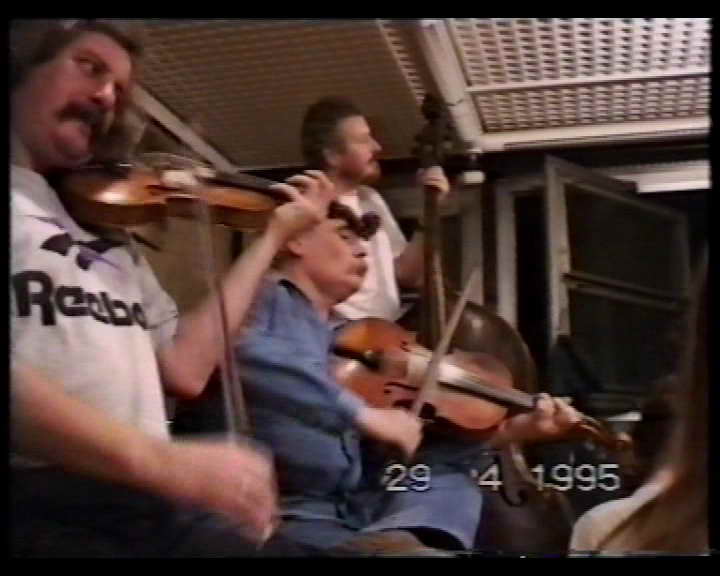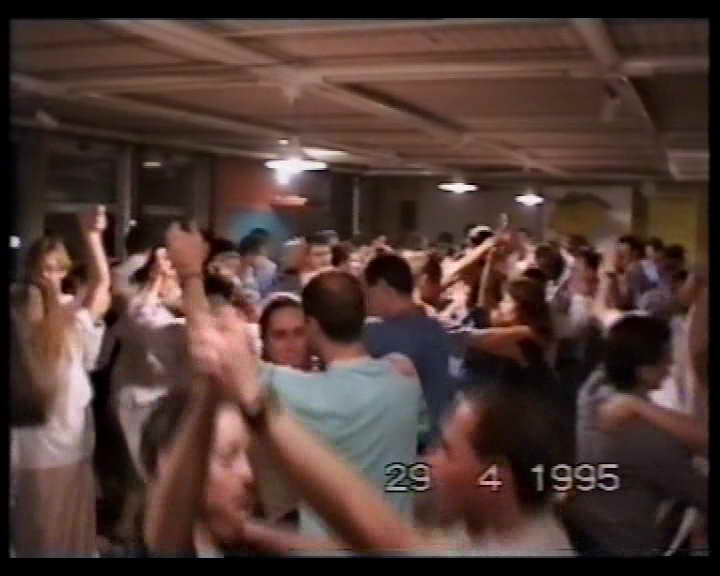How can a modern, urban, public dance-house (táncház) be good?
attendees:
good host
cordial, dynamic, decisive
an example is the Kalamajka dance hall in Molnár Street in the 90s with dance teacher-host Karcsi György
good audience
preferably people who at least partly know each other and are on good terms
at least half of them should know the dance, singing and not be spoilsports
They should be in the mood for the whole thing. Often a tourist who knows nothing is visibly more happy to dance than a professional dancer. Don't be boring, especially forced. (This is the sin of schooling.) If there are several generations together, or any one separately, everyone should find a dancing or talking partner.
Good band
listen to the dancers (in addition to the quality of the music detailed elsewhere) (this is especially important for bachelor, for songs requested/started by the dancers, for tempo selection for tap), play music with heart, don't take too long a break
music:
sound system
Music should preferably be without amplification. If it is necessary (only for audiences of over 100-200 people, because the string orchestra has been able to cope with it in Transylvania and in the big dance halls in Budapest, at least in rooms with tolerable acoustics), it should not be louder than live music in a smaller room, i.e. it should not overpower the singing and it should be possible to talk comfortably. The singer of the orchestra (especially at high volume) makes one of the essentials of live dance music impossible, discourages and makes the guests and dancers singing at their own will, at their own pleasure, insecure.
The possibility of sound (and radio, CD, cloud) also leads to the situation (fortunately rare in folk music) that thousands, tens of thousands, millions listen to a "star" band, but communities are disappearing and family, village, village bands cannot compete with the terribly professional ones in quality either.
A good example of the lack of sound system is the 90's Molnár Street Kalamajka dance hall.
Length of music, time
It's good if the music is playing when the first people enter the ball. The atmosphere is already different. In the past (maybe the best dancing) girls have danced to this, which was practice and showed what they could do to the arriving guys. In such a case, a dance of the accordion is appropriate, sad songs are for later. The orchestra warmed up during the dance. In Sófalva, after four hours of music, the musicians had a meal break. It's bad to have silence without conversation, and it's also bad when the guests dance and sing, but the orchestra is gone. There is no room for bachelor dancing after a tiring fast dance, at most with a rest.
tuning theory
These suggest that natural overtone scales and evenly tempered scales and their instruments differ greatly. One theory is that natural is good, healthy and human. There is also the question of what they produce when used together. (A violin tuned to overtone and a concertina.) Singers sing according to what? Kodály said, "As a result of the constant use of the piano, even famous choirs often sing falsely."
pitch
The current 440Hz "A" sound used to be lower in many different and diverse ways. This can be related to all kinds of vibrations, from musical instruments to people to the ground. Not sure if today's uniform pitch is right.
We tune to 432 Hz when we tune.
Part of this may be related to how singable the songs are that musicians play. for example, we play the chedi mostly in A, which may be higher than the old tuning. In addition, on older recordings, many of the songs are played one note lower, in G. (Although in other places the musicians tuned the instrument higher to make it louder. But did it make them sound uglier?) The pitch also depends on whether the singers are male, female or mixed.
dancing, singing:
Teaching
It was very good at the Kalamajka dance hall in the 1990s to have teaching during the dance routines in the back, away from the orchestra. This is even more important in Moldavian dance halls, because clumsy beginners who bravely step in can completely ruin a circle dance, which is all about moving together. And in couples dances, they bump into each other. But their partner is also usually uncomfortable with a dancer who's going in the wrong direction.
example of Moldavian Csángó serba circle dance with Hungarian dancers and Csángó (young people from Pustina performing in the 90s, 1:33 - 2:30 in the recording)
one or more regions
Of course, in traditional dance halls only local music was played, in the dance hall movement usually more. It's a good try to have one kind, it's easier to learn the dances, the songs too, no change of style. There have always been Moldavian and Gyimes dance houses (Tatros band). We also held regular Szekler and sometimes Székely dance houses. One kind of dance-house for one occasion is organised more often. Nowadays, with the mix of urban and rural landscapes, it is difficult, because you have to know more than one thing to go to a dance house.
tempo
In general, it seems that at least since the 2nd war, the tempo of the dances has been accelerating (see Lajtha's descriptions of the chair), along with "life" (from the invasion of the consumer social order into our country, the acceleration of speech is also evident, as exemplified by the advertisement of medicine.) We try to play at a slower pace as much as possible. Perhaps this rush is not good, even if it has become habitual and therefore expected.
figures
In the dance movement, the dance of a particular region has also become complicated due to choreography, learning from recordings, and the more=better mindset. Among the villagers of old, only one to one fiddled the way dancers expect of each other today. Moreover, they knew the dances of one region, we need to know at least five of them if we want to dance the best of the dances in an average dance hall. That's why it's important not to stick to the perfect dance, but of course not to disturb the others. Unfortunately, the once basic dance order of the dance house, the Sék dance, has become boring in the eyes of most people - you can't put figures into it.
Invited by
According to traditional dance-hall descriptions, asking a bachelor to dance was impossible, it involved dancing out. Of course, even rough approaches were prevented by customary law or the dance hall management (e.g. in Szék). Of course, it works differently (worse) among strangers than in a close-knit, familiar group. Obviously, it is also to be avoided that boys who can't dance at all or who are drunk and staggering around dragging girls along. The result of the widespread refusals, which are neither justified nor apologetic, is that the lads only ask the girls they know for sure, which is why many girls who want to dance are left sitting. It is fortunate if it is perceived who can and will dance and who cannot. It is also good for this if girls dance with each other. It is also good if only the one who wants to dance sits in the dance room, the others sit further away.
singing
Singing during and after the dances is also essential for the atmosphere of the dance. Unfortunately, and this is also true for dances, the more dances and songs of different regions are studied in different places, the more difficult it is to have fun together. And if we don't know anything, even more so. The verse variations of the songs also make it difficult. However, the presence of a lead singer with a good voice can solve this.
architecture, clothing:
clothing
Folk costumes, or similar clothing, certainly improve the atmosphere of a dance. (Of course, any kind of clothing can be perfect for the atmosphere.) It is also not a bad thing to have a line-up of dances from several regions.
The advantage of a heavy old skirt is that you can spin in it in the traditional way.
In general, the sight of long skirts, especially when dancing, makes a dance much more beautiful and atmospheric. For a man dancing with a girl in a skirt, a flying skirt is a different sight than nothing.
Thick woollen dresses absorb sweat and evaporate it over a large surface area, so the girls are not clutching wet T-shirts and splashing sweat on them. And if a girl's shoulders or arms are covered by a dress, she doesn't have to cling to her slippery skin. It's also easier to "keep your distance".
Any kind of belt, but especially a thick Moldavian belt, makes the appropriate circle dances quite different.
space, room, building
Today's domestic halls, classrooms and cultural buildings are mostly inhospitable and ugly. Their form, decoration, entrance are inhospitable. The best is an open-air, wooded grove, a fire. Although today few people like to walk in natural spaces (especially this accelerated dance).
light
In many places, girls had to go home from traditional spinning at sunset. There were lights at the balls, of course. The fire was the most beautiful. A ballroom chandelier, with lots of bulbs (tungsten) and sparkling glass, gave a lovely glow. In Transylvania in the 80's there was only money for 1-2 bulbs and enough light. Too bright a light is bad, especially if it is of poor quality. The light from fluorescent tubes and lamps is ugly, unhealthy and inhospitable. They also spoil the atmosphere of the dance hall. It is no coincidence that in one of the best dance halls of the 90s, in Molnár Street, small incandescent lamps were always placed on the ceiling, turning off the overly bright fluorescent lamps that emit electro-smog, flashing invisibly, buzzing, white light from the hospital.
floor
The wooden floor is the good one. In comparison, even where it is (MOM, Budapest), it is covered with plastic for fear of wear and tear. Although this way, even if they make it ugly and toxic, at least it retains its flexibility. Many professional dancers' knees have been ruined forever by the hard floors of rehearsal and performance venues (stone, concrete, gres)
air
It's a good thing that (in Hungary at least) there is no more tobacco smoke, especially in the dance floor. Since the ceiling height is usually low or the window cannot be opened because of the surrounding flats, the air is running out. Air conditioning is even worse, its draught can cause serious illness, it never meets air speed standards, it is usually too cold and full of bacteria. It's also ridiculous for something as traditional as air conditioning for a dance hall that mimics spinners. We should have wide ceilings in the dance halls with side rooms outside the dance halls, with windows in them too, so the winter cold doesn't beat down on the dancers, and there is ventilation while dancing.
flash, mobile, recording - who's the music for?
A video camera moving among the dancers is distracting. Especially in darkness, candlelight, firelight, flash, and even mobile phone use (on a normal white background, which illuminates the surroundings) also spoils the environment of those present.
As is traditional, the dance should be for the benefit of the community of those present, not for archiving and instantly informing those who are absent. Let's not ruin the gathering with the fashion of technology and telecommunications.
The former Molnár Street Kalamajka dance hall
My own memories, my own recordings of a really good Budapest dance hall. A good part of the above can be seen here. Good band, good audience, light bulb, openable window, no amplification...
Gergő Sámsondi
Kisecset, 2019

 English (UK)
English (UK)  Polski (PL)
Polski (PL)  magyar (HUN)
magyar (HUN) 
